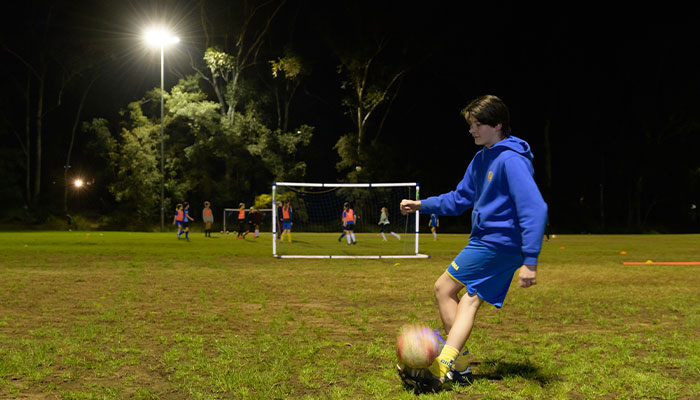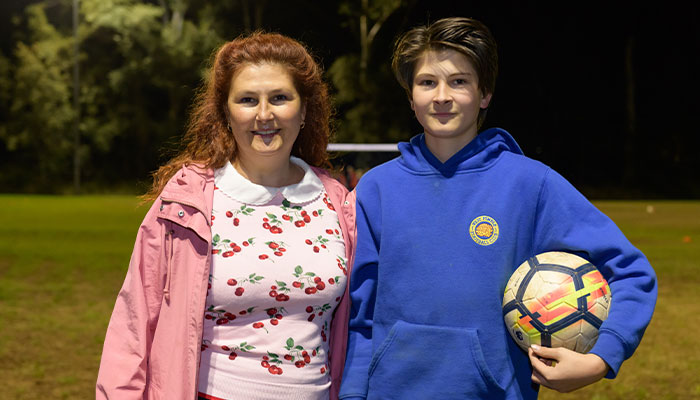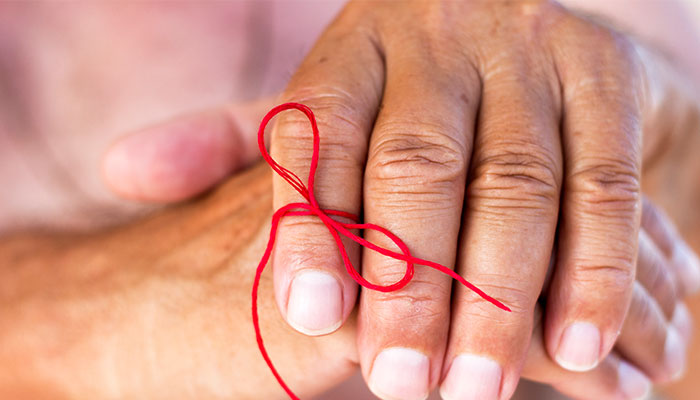On average, more than 28,000 children each year end up in hospital somewhere in Australia with a broken bone from playing sport, a new study from Macquarie University shows.

Back in action: Footballer Max Braun, 15, is one of the more than 28,000 children hospitalised each year in Australia for fractures.
Piecing together data over a 10-year period on injuries suffered by children up to 16 years old, Macquarie researchers found broken bones to be the single biggest cause of hospitalisation accounting for 41 per cent of all paediatric trauma admissions. Of 686,409 children admitted to hospital over 10 years as a result of an injury, the largest number (287,646) were hospitalised for fractures.
One addition to the statistics in April was 15-year-old Max Braun, who plays club-level football. He was left writhing on the ground after a tackle during the season’s first trial match. “We could see the coach holding Max’s leg at a strange angle,” says his mother, Irina. “He seemed to be in a lot of pain, and then he passed out intermittently.”
As well as the immediate pain and suffering to the child, the researchers discovered that fractures directly cost the Australian health system about $73.2 million a year.
Boys are more likely to engage in risk taking type behaviors and they are more likely to play contact sports than girls.
“There’s emotional distress, the fact that parents have to take time off work and the child misses school,” says the study’s lead researcher, Associate Professor Rebecca Mitchell from the Australian Institute of Health Innovation (AIHI) at Macquarie. “In extreme cases, the child might face a life of disability and chronic pain.”
The five most common fractures were the forearm (48.1%), shoulder and upper arm (14.1%), lower leg including the ankle (11.3%), wrist and hand (10.4%), and the skull and face (9%).
Mitchell and her team published their results on children’s fractures in the international journal Injury in July, part of a larger study of a decade’s worth of data on children hospitalised for injury. It included separate papers on head injury, self-harm, spinal injuries and burns.
Set boundaries, manage the risk
“Our study is one of the largest studies of child injury, hospitalisations and health outcomes conducted in Australia,” Mitchell says. “It's the first time that injury characteristics and survival have been examined nationally.”
Twice as many boys as girls were hospitalised for fractures – around 820 hospitalisations per 100,000 boys – compared to girls with around 416 hospitalisations per 100,000, the AIHI study found.
“This is because boys are more likely to engage in risk-taking type behaviors and they are more likely to play contact sports than girls,” Mitchell says.
It's about encouraging them to take risks, but not extreme risk. We need to set some boundaries, understand the hazards and manage the risks.
The main driver of the AIHI team’s research is to have an impact on improving children’s safety and also change government policy, Mitchell says. The research team presented their research findings to the Minister for Health, Greg Hunt.
They have also joined other academics advising the Department of Health on a new National Injury Prevention Plan which opened to public comment in June.
- New hope as dementia therapy reverses memory loss
- Smart UV sensor a world first to alert users to over-exposure
Mitchell emphasises that preventing injury is not about wrapping children in cotton wool or discouraging them from playing sport.
“You don't want them to grow up with a sedentary lifestyle,” she says “It's about encouraging them to take risks, but not extreme risk. We need to set some boundaries, understand the hazards and manage the risks.”
Max's road to recovery
The government’s draft plan will help sporting clubs and schools develop safety policies and practices including the compulsory use of protective equipment, improve the education of players and parents, maintain sporting fields, as well as develop new refereeing rules and coaching standards.

Time heals: Max, with his mum Irina, was thrilled to get back on the field after recovering from a broken ankle.
As for Max, he regained consciousness in the ambulance as they rushed him to Sydney’s Royal North Shore Hospital. He had dislocated and broken his ankle. Doctors put in a pin to keep the two bones straight, which they took out six weeks later.
He then spent six weeks on crutches, with his parents alternately taking time off work over the week he spent at home.
“Ironically, we all then went into lockdown so everyone was at home anyway and he wasn’t missing out on school or soccer,” Irina says. “It gave Max time to get his strength back in his leg and do his exercises.”
Max returned to playing regular matches a month ago. “He was a bit cautious at first but then he got right back into it and was absolutely over the moon when he came off the field."
Rebecca Mitchell is an Associate Professor with the Centre for Healthcare Resilience and Implementation Science in the Australian Institute of Health Innovation at Macquarie University.



